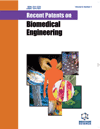- Home
- A-Z Publications
- Recent Patents on Biomedical Engineering (Discontinued)
- Previous Issues
- Volume 6, Issue 1, 2013
Recent Patents on Biomedical Engineering (Discontinued) - Volume 6, Issue 1, 2013
Volume 6, Issue 1, 2013
-
-
3D Cell and Scaffold Patterning Strategies in Tissue Engineering
More LessAuthors: Michael J. Sawkins, Kevin M. Shakesheff, Lawrence J. Bonassar and Glen R. KirkhamMany tissue engineering constructs comprise scaffolds with spatially homogenous properties that have uniformly seeded populations of cells. The broadly uniform morphologies of such constructs do not reflect the complexity of the tissues they are designed to emulate, limiting their application for future clinical goals. In order to begin to address this limitation, a range of technologies have been developed that are better able to Read More
-
-
-
Recent Advancements in Soft Tissue Regeneration
More LessAuthors: James A. Cooper, Brittany Ferraro and Andreas ChristensenIn this millennium, tissue engineering for soft tissue repair has expanded to include regenerative medicine. Researchers are tirelessly developing new ideas and methods for engineering fully functional tissue. Introduced are four major areas of soft tissue musculoskeletal research: ligament, cartilage, muscle and rotator cuff. Investigators are pursuing tissue regenerative medicine therapies to provide functionality and promot Read More
-
-
-
A Review of Current Advances in Biomaterials for Neural Tissue Regeneration
More LessAuthors: Thanh Yen Nguyen and Huinan LiuThis review discusses current strategies, patents, and ongoing research that address the limitations of current practices and FDA approved devices for neural tissue regeneration. Current clinical practices for treating peripheral nerve damage utilize autografts and nerve guidance conduits (NGCs), which are only applicable for small nerve gaps of around 30 mm. Furthermore, there are no clinical treatments for central nerv Read More
-
-
-
Recent Advances in Bone Graft Technologies
More LessAuthors: B.L. Taylor, T. Andric and J.W. FreemanBone is a living, dynamic, vascular, mineralized, connective tissue, characterized by its hardness, resistance and ability to remodel and repair itself. It provides structural support and protection for the bone and vital organs and it serves as a mineral (calcium) and blood cell reservoir for the body. Bone loss and skeletal deficiencies due to traumatic injury, abnormal development, or cancer are major problems worldwide, frequently Read More
-
-
-
Design and Application of Magnetic-Based Theranostic Nanoparticle Systems
More LessAuthors: Aniket S. Wadajkar, Jyothi U. Menon, Tejaswi Kadapure, Richard T. Tran, Jian Yang and Kytai T. NguyenRecently, magnetic-based theranostic nanoparticle (MBTN) systems have been studied, researched, and applied extensively to detect and treat various diseases including cancer. Theranostic nanoparticles are advantageous in that the diagnosis and treatment of a disease can be performed in a single setting using combinational strategies of targeting, imaging, and/or therapy. Of these theranostic strategies, magnetic-based Read More
-
-
-
Recent Patents on Accuracy of Blood Pressure Measurement
More LessBlood pressure measurement (BPM) accuracy is greatly important for adequately preventing, diagnosing, and treating many associated cardiovascular diseases. This paper presents a review of the factors determining the BPM accuracy such as the record accuracy, different artifacts, simulators, test devices, algorithmic meanings for blood pressure determination, appropriate choice of cuff and pump, data signal proce Read More
-
Most Read This Month
Article
content/journals/biomeng
Journal
10
5
false
en


